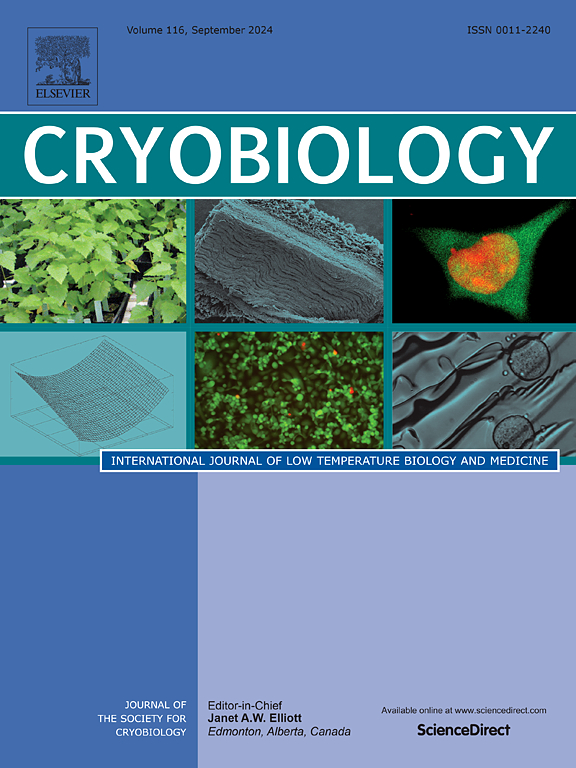肌醇抗氧化活性对超速冷冻法和传统冷冻法中人类精子参数和 DNA 损伤的影响
IF 2.3
3区 生物学
Q2 BIOLOGY
引用次数: 0
摘要
精子冷冻保存过程中诱发的细胞损伤以及精子结构和功能受损仍然是男性生育力保存面临的挑战。与传统冷冻方法相比,精子超快速冷冻虽然具有更高的保护效果,但仍存在精子冷冻存活率不达标的问题,因此需要对其进行改进,以提高其保护精子的效率。添加抗氧化剂的精子冷冻培养基可改善冷冻-升温过程中的精子参数。本研究旨在探讨超快速冷冻和肌醇对精子冷冻存活的影响。我们收集了30份精子参数正常的精液样本,并将每份样本分成四份,分别采用常规冷冻、超快速冷冻、常规冷冻+肌醇2毫克/毫升、超快速冷冻+肌醇2毫克/毫升进行冷冻保存。通过评估精子的运动能力、存活率、形态和DNA碎片指数(DFI),对冷冻至少24小时后加热的精子样本和精子冷冻存活率进行分析。冷冻方法对解冻后精子的 DFI 和形态有显著影响(p本文章由计算机程序翻译,如有差异,请以英文原文为准。
The effect of myo-inositol antioxidant activity on human sperm parameters and DNA damage in ultra-rapid and conventional freezing methods
Male fertility preservation is still challenged by cell damage induced during sperm cryopreservation and impaired sperm structure and function. Sperm ultra-rapid freezing, despite a higher protective effect compared to conventional freezing method, is still associated with suboptimal sperm cryosurvival and needs to be modified to increase its efficiency in sperm protection. Sperm freezing media supplemented with antioxidants can improve sperm parameters following freezing-warming process. In this study, we aimed to investigate the effect of employing ultra-rapid freezing and myo-inositol on sperm cryosurvival. Thirty semen samples with normal sperm parameters were collected and each one was divided into four portions to cryopreserve by conventional freezing, ultra-rapid freezing, conventional freezing + myo-inositol 2 mg/ml, and ultra-rapid freezing + myo-inositol 2 mg/ml. Sperm samples warmed after at least 24 h of freezing and sperm cryosurvival were analyzed by evaluation of sperm motility, viability, morphology and DNA fragmentation index (DFI). Freezing method had a significant influence on post-thaw sperm DFI and morphology (p < 0.05) and the interaction between freezing method and antioxidant supplementation significantly affected sperm morphology (p < 0.05). The highest percentage of sperm normal morphology and minimal DFI was achieved using ultra-rapid freezing supplemented by myo-inositol antioxidant compared to other groups (P < 0.05). The highest sperm DNA damage after freezing-warming was observed following the conventional freezing method. In conclusion, sperm freezing method was identified as factor strongly influencing sperm DFI and morphology after thawing/warming. Sperm samples can be rapidly frozen using the modified freezing media supplemented by myo-inositol without impacting sperm DNA and morphology.
求助全文
通过发布文献求助,成功后即可免费获取论文全文。
去求助
来源期刊

Cryobiology
生物-生理学
CiteScore
5.40
自引率
7.40%
发文量
71
审稿时长
56 days
期刊介绍:
Cryobiology: International Journal of Low Temperature Biology and Medicine publishes research articles on all aspects of low temperature biology and medicine.
Research Areas include:
• Cryoprotective additives and their pharmacological actions
• Cryosurgery
• Freeze-drying
• Freezing
• Frost hardiness in plants
• Hibernation
• Hypothermia
• Medical applications of reduced temperature
• Perfusion of organs
• All pertinent methodologies
Cryobiology is the official journal of the Society for Cryobiology.
 求助内容:
求助内容: 应助结果提醒方式:
应助结果提醒方式:


